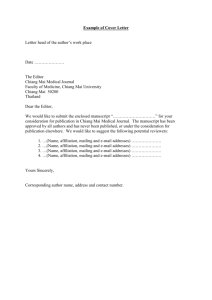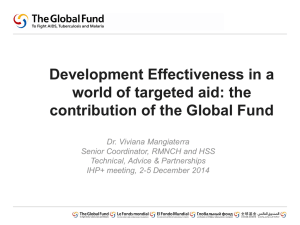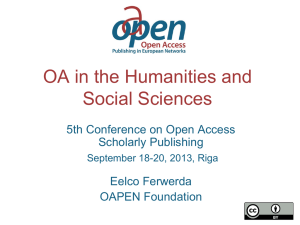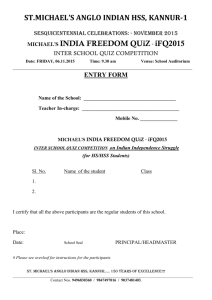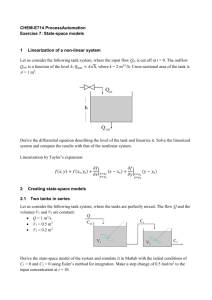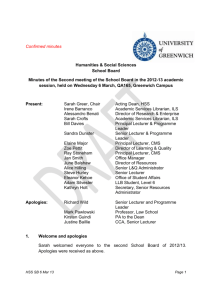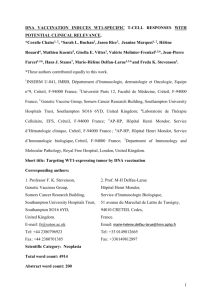Inhibitory effect of mammea E/BB from Mammea
advertisement
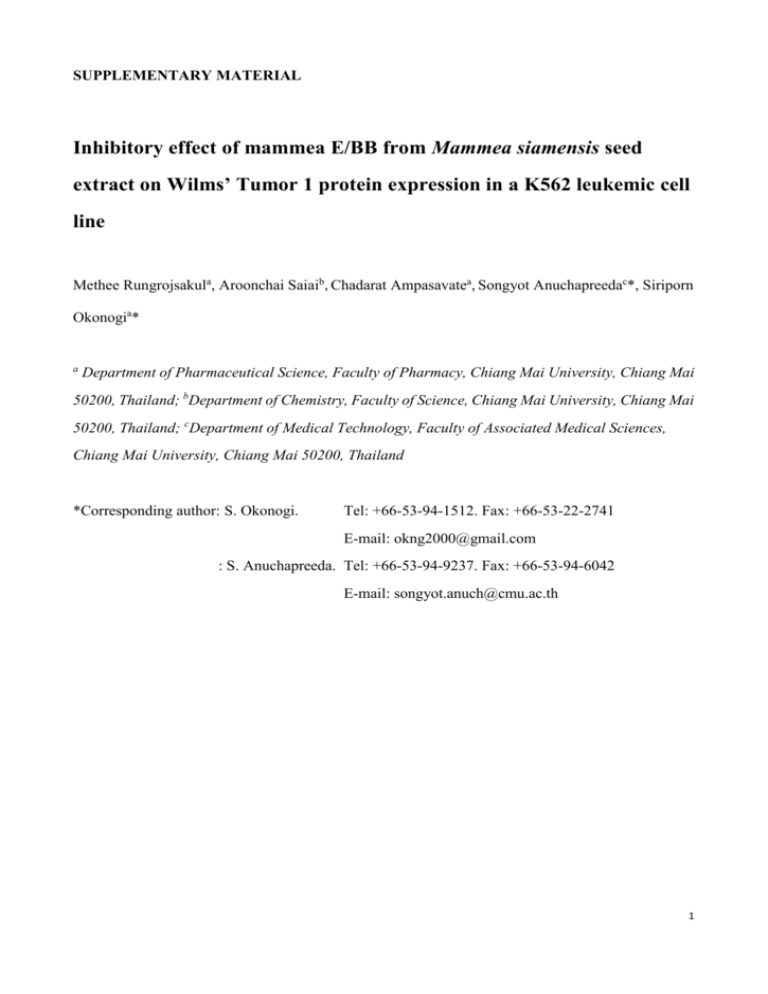
SUPPLEMENTARY MATERIAL Inhibitory effect of mammea E/BB from Mammea siamensis seed extract on Wilms’ Tumor 1 protein expression in a K562 leukemic cell line Methee Rungrojsakula, Aroonchai Saiaib, Chadarat Ampasavatea, Songyot Anuchapreedac*, Siriporn Okonogia* a Department of Pharmaceutical Science, Faculty of Pharmacy, Chiang Mai University, Chiang Mai 50200, Thailand; bDepartment of Chemistry, Faculty of Science, Chiang Mai University, Chiang Mai 50200, Thailand; cDepartment of Medical Technology, Faculty of Associated Medical Sciences, Chiang Mai University, Chiang Mai 50200, Thailand *Corresponding author: S. Okonogi. Tel: +66-53-94-1512. Fax: +66-53-22-2741 E-mail: okng2000@gmail.com : S. Anuchapreeda. Tel: +66-53-94-9237. Fax: +66-53-94-6042 E-mail: songyot.anuch@cmu.ac.th 1 Abstract Mammea siamensis is used in traditional Thai medicine. This study was designed to extract and isolate an active compound from the M. siamensis seeds and investigate its activity on Wilms’ tumor 1 (WT1) protein expression in K562 cells. WT1 is a transcription factor that stimulates cell proliferation. The ethanol extract (ESS) was fractionated using n-hexane, ethyl acetate, n-butanol, and water to obtain HSS, EASS, BSS, and WSS extracts, respectively. The ESS, HSS, and EASS extracts had strong cytotoxic effects on K562 cells in the MTT assay. All three fractions decreased WT1 protein levels and decreased total cell numbers. The HSS extract decreased the WT1 protein levels in a time- and dose-dependent manner. HPLC and NMR analyses indicated that the active compound of HSS was mammea E/BB. M. siamensis seeds are thus identified as a promising source of bioactive compounds for potential inhibition of WT1 protein expression. Keywords: Mammea siamensis; mammea E/BB; Wilms’ tumor 1; Leukemia, K562 Abbreviations: WT1, Wilms’ tumor 1; GAPDH, glyceraldehyde phosphate dehydrogenase; BSS, n-butanol saraphi seed; EASS, ethyl acetate saraphi seed; ESS, ethanol saraphi seed; HSS, n-hexane saraphi seed; WSS, water saraphi seed. Sur A, surangin A; Sur C, surangin C; E/BB, mammea E/BB 2 1. Experimental 1.1. Plant material M. siamensis seeds were obtained from Chiang Mai University, Amphoe Muang, Chiang Mai province, Thailand in May 2010. A voucher specimen (J.F. Maxwell, No.92-70) was deposited by the CMU herbarium, Faculty of Science, Chiang Mai University, Chiang Mai, Thailand. 1.2. Extraction and isolation The M. siamensis seeds (10 kg) were washed, chopped into small pieces, and then dried by circulating dry air in an oven at 50°C. The dried weight yield of M. siamensis seed was 1 kg (10%). The dried seed (1 kg) was macerated in 95% ethanol and concentrated using an evaporator at 50°C. After evaporation, the ethanolic crude extract was collected, with the final yield of 10% (100 g). The crude ethanolic extract was suspended in water and sequentially partitioned by n-hexane, ethyl acetate, and n-butanol, respectively. The solvent from each fraction was evaporated and further dried at room temperature. After the removal of solvents, the fractional yield of products of the n-hexane, ethyl acetate, n-butanol, and water fractions were 81.5, 5.2, 5.4, and 7.9%, respectively (Table S1). A portion of the crude hexane extract (25 g) was separated by column chromatography on silica gel 60 using gradient elution from 100% n-hexane to 100% ethyl acetate to give four separate fractions. Surangin C was found mainly in the fourth fraction as characterized by 1H NMR. Fraction number 2 was further separated by column chromatography eluted by a n-hexane and ethyl acetate gradient to give subfractions 2.1-2.5. Subfraction 2.2 was surangin A. Fraction 3 was rechromatographed in a silica gel column using gradient elution from 100% n-hexane to 50% ethyl acteate/n-hexane to give subfractions 3.1-3.4. Subfraction 3.3 was identified as mammea E/BB (Figure S2). The presence of surangin A, surangin C, and mammea E/BB were confirmed by NMR analysis. The 1H NMR spectra were recorded using a Bruker AV 400 spectrometer. The chemical shifts were recorded in ppm () in CDCl3 using residual solvent peak ( 7.26) as internal references. 1.3 Analysis of HSS extracts using high performance liquid chromatography (HPLC) 0.5 – 100 mg portions of samples were dissolved in 1 mL of ethanol for HPLC analysis. The samples were analyzed using a Dionex ICS-3000 HPLC system with a PDI-100 photodiode array detector. A C18 column (150×4.6 mm, 5 µm particle size, Nucleodur®) with a guard column was 3 used. For the elution of the constituents, two solvents (denoted as A and B) were applied. A was 1 % v/v acetic acid in water whereas B was 1 % v/v acetic acid in acetonitrile. The isocratic program was 5% A and 95% B for 30 min. The flow rate was 0.5 mL min-1 at room temperature and the injection volume was 20 µL. The retention times and UV spectra of major peaks were recorded. The HPLC chromatogram of HSS showed four main peaks at retention times of 8.9, 9.6, 19.3, and 20.8 min using a wave length of 280 nm. A portion of the crude hexane extract (25 g) was further purified by column chromatography using silica gel 60 and characterized by 1H NMR to obtain surangin A (Joshi et al. 1969), surangin C (Yagi et al. 2006), and mammea E/BB (Laphookhieo et al. 2006). The NMR analyses of surangin A, surangin C, and mammea E/BB are shown in Figures S3(A) - S3(C) respectively. The mammea E/BB fraction was then confirmed by the HPLC. The mammea E/BB’s peak occurred at the retention time of 8.9 min (Figure S4(A), S4(B)). 1.4 Cells and cell culture conditions The K562 cells (chronic myelocytic leukemic cell line) were cultured in RPMI-1640 medium containing 10% fetal calf serum, 1 mM L-glutamine, 100 units mL-1 penicillin, and 100 µg mL-1 streptomycin (InvitrogenTM Life, Carlsbad, CA, USA). Cells were incubated at a humidity of 95%, 5% CO2 atmospheric concentration, and a temperature of 37°C. 1.5 MTT cytotoxicity assay The cytotoxicity of ESS extracts, other fractional extracts (HSS, EASS, BSS, and WSS), and purified compounds (Sur A, Sur C, and E/BB) were evaluated using the MTT assay as described previously (Anuchapreeda et al. 2006). Briefly, cells (1.0 × 104 cells well-1) were treated with ESS and fractional extracts of various concentrations (3 to 100 µg mL-1) for 48 or 72 h. The cell cytotoxicity was determined using MTT dye solution (Sigma-Aldrich, St Louis, MO, USA) and detected using an AccuReaderTM microplate reader (Metertech-Inc, Taipei, Taiwan) at 578 nm with reference wavelength of 630 nm. The percent of cell viability was calculated by OD (treatment) ×100 / OD vehicle control. The inhibitory concentration for 50% of cell growth (IC50) values was calculated as the means ± standard errors of the means (SEM), and their activities compared. 4 1.6 Protein extraction and Western blotting The whole protein extracts from the treated cells were prepared using RIPA buffer (50 mM Tris-HCl, 150 mM NaCl, 1% Triton X-100, 0.5 mM EDTA, 0.1% SDS, and a protease inhibitor cocktail). The protein concentration was measured using the Folin-Lowry method. The proteins were separated by 12% SDS polyacrylamide gel electrophoresis. The levels of WT1 protein were determined by a primary rabbit polyclonal anti-WT1 (Santa Cruz Biotechnology, CA, USA) with a dilution of 1:100, followed by HRP-conjugated goat anti-rabbit IgG (Promega, Madison, WI, USA) with a dilution of 1:20,000. The GAPDH protein was probed by primary rabbit polyclonal anti-GAPDH (Santa Cruz Biotechnology, CA, USA) with the dilution of 1:1,000, followed by HRP-conjugated goat anti-rabbit IgG with the dilution of 1:20,000. The proteins were visualized using the LuminataTM Forte Western HRP Substrate (Merck Millipore Corporation, Billerica, MA, USA) and quantified by the ChemiDocTM XRS system (Bio-Rad, Hercules, CA, USA). 1.7 Statistical analysis All data were expressed as the mean+standard deviation (SD) or mean+standard error of the mean (SEM) from triplicate samples of three independent experiments. The statistical differences between the means were determined using one-way ANOVA. The differences were considered significant when the probability value obtained was found to be less than 0.05 (p< 0.05). 5 Table S1. Percent yield of crude, fractional M. siamensis seed extracts and pure compounds from n-hexane fraction; surangin A, surangin C, and mammea E/BB (%w/w) after column chromatography (%w/w) Sample Fresh seed - Dry seed Sample code %Yield (w/w) - 100 - 10 Dry seed (10%) - Ethanol extract 100 ESS Ethanol extract - n-Hexane extract - Ethyl acetate extract - 10 100 HSS 81.5 EASS 5.2 n-Butanol extract BSS 5.4 Water extract WSS 7.9 Hexane fraction (HSS) 100 - Surangin A Sur A 0.5 - Surangin C Sur C 35.7 - Mammea E/BB E/BB 9 - Others - 54.8 6 Figure S1. Inhibitory effects of ESS, HSS, and EASS extracts on WT1 protein levels and cell numbers in K562 cells. (A) Cells were treated with 1.5 µg mL-1 of ESS, HSS, and EASS extracts for 72 h. Levels of WT1 protein were assessed by Western blotting; GAPDH was used as the loading control. (B) The protein levels were analyzed with a scanning densitometer. (C) The total cell number of K562 cells after treatments for 72 h was determined by the trypan blue exclusion method. (D) K562 cells were treated with HSS extract for 24, 48, and 72 h. (G) WT1 protein levels after HSS treatment (0.25, 0.5, and 1 µg mL-1) for 72 h. (E, H) The protein levels were analyzed using a scanning densitometer. (F, I) The total cell numbers after treatments with various concentrations and times were determined by the trypan blue exclusion method. Data are the mean values ± SEM of three independent experiments. Asterisks (*) denote significant difference from the vehicle control (p<0.05). 7 HSS (25g) Fraction no.1 (4.5 %) Fraction no.2 (7.4 %) Fraction no.3 (45.9 %) F 3.1 (8.7 %) F 2.1 (0.35 %) F 2.2 (0.5 %) Surangin A (1) F 2.3 (5.2 %) F 3.2 (21.9 %) F 2.4 (0.2 %) Fraction no.4 (35.7 %) Surangin C (2) F 3.3 (9 %) Mammea E/BB (3) F 3.4 (4.6%) F 2.5 (0.4 %) Figure S2. Fraction number and percent yields of surangin A (1), surangin C (2), and mammea E/BB (3) (%w/w) after silica gel 60 column chromatography. 8 1 Surangin A : Yellowish gum; H NMR (400 MHz, CDCl ) δ 14.61 (s, 1H), 7.09 (s, 1H), 6.01 (s, 1H), 5.22 (t, J 3 = 6.6 Hz, 1H), 5.09 – 4.99 (m, 1H), 3.95 – 3.88 (m, 1H), 3.50 (d, J = 6.9 Hz, 2H), 2.93 (t, J = 7.4 Hz, 2H), 2.11 (d, J = 1.9 Hz, 4H), 1.85 (s, 3H), 1.7-1.4 (m, 4H), 1.67 (s, 3H), 1.59 (s, 3H), 1.24 (dd, J = 6.6, 2.4 Hz, 3H), 1.03 – 0.96 (m, 6H) Surangin C : Yellowish gum; 1H NMR (400 MHz, CDCl3) δ 14.15 (s, 1H), 10.82 (s, 1H), 6.02 (s, 1H), 5.13 (t, J = 6.6 Hz, 1H), 4.99 (t, J = 6.7 Hz, 1H), 4.64 (dd, J = 7.8, 6.4 Hz, 1H), 3.69 – 3.60 (m, 1H), 3.36 – 3.31 (m, 2H), 2.03-1.95 (m, 4H), 1.94 – 1.83 (m, 3H), 1.73 (s, 3H), 1.57 (s, 3H), 1.50 (s, 3H), 1.14 (d, J = 6.7 Hz, 4H), 0.94 (t, J = 7.5 Hz, 3H), 0.88 (t, J = 7.4 Hz, 3H) Mammea E/BB : Yellowish gum; 1H NMR (400 MHz, CDCl3) δ 14.60 (s, 1H), 7.45 (s, 1H), 6.46 (dd, J = 8.0, 2.7 Hz, 1H), 6.24 (s, 1H), 5.12 (t, J = 7.0 Hz, 1H), 3.84 (sextet, J = 6.7 Hz, 1H), 3.33 (d, J = 7.0 Hz, 2H), 2.16 (s, 3H), 1.99 – 1.90 (m, 2H), 1.90 – 1.80 (m, 1H), 1.77 (s, 1H), 1.72 (s, 1H), 1.48 – 1.34 (m, 1H), 1.22 (d, J = 6.6 Hz, 3H), 0.98 (t, J = 7.4 Hz, 3H), 0.93 (t, J = 7.4 Hz, 3H) Figure S3. Detection of surangin A, surangin C, and mammea E/BB by nuclear magnetic resonance (NMR). (A) Surangin A, (B) surangin C, and (C) mammea E/BB were obtained from the fractions using silica gel 60 column chromatography. 9 Figure S4. Chromatograms of HSS and mammea E/BB by high performance liquid chromatography and UV detection (HPLC-UV). (A) HSS and (B) mammea E/BB were obtained from the fractions after normal phase column chromatographic separation. Concentrations of HSS and mammea E/BB were 100 mg mL-1 and 0.5 mg mL-1, respectively. Injection volume was 20 µL. 10 References Anuchapreeda S, Thanarattanakorn P, Sittipreechacharn S, Chanarat P, Limtrakul P. 2006. Curcumin inhibits WT1 gene expression in human leukemic K562 cells. Acta Pharmacol Sin. 27:360-366. Joshi BS, Kamat VN, Govindachari TR, Ganguly AK. 1969. Isolation and structure of surangin A and surangin B, two new coumarins from Mammea longifolia (wight) Planch and Triana. Tetrahedron. 25:1453-1458. Laphookhieo S, Maneerat W, Kiattansakul R. 2006. Phenolic compounds from Mammea siamensis seeds. Can J Chem. 84:1546-1549. Yagi N, Ohkubo K, Okuno Y, Oda Y, Miyazawa M. 2006. Antimutagenic compound from Yellow batai (Peltophorum dasyrachis). J Oleo Sci. 55:173-180. 11
